Home / Eye Color Change for Damaged Eyes


Eye Color Change Options for Damaged or Injured Eyes
Changing eye color is no longer just a cosmetic trend—it’s becoming a therapeutic option for those with eye trauma, corneal scars, or pigment damage. With advances in medical aesthetics, particularly in countries like Iran and Oman, individuals with eye injuries now have safe and effective methods to restore or enhance their eye appearance. Ceritamed, a leading eye aesthetics center, offers specialized services in keratopigmentation and laser eye color change tailored specifically for damaged eyes.
What Are the Safest Methods to Change Eye Color After Trauma?
When it comes to injured or previously damaged eyes, safety is the number one concern. Fortunately, recent innovations have made eye color change procedures safer and more precise. The most recommended method for people with eye trauma is Keratopigmentation or KTP which is a non-invasive procedure that adds color to the cornea by using a FDA Approved pigment. Unlike iris implants, which pose higher risks especially in compromised eyes, this method is specifically adapted for individuals with trauma history, offering both cosmetic and reconstructive benefits.
However, in cases where the iris has been completely destroyed (aniridia) or seriously damaged, implantation of an artificial iris may be the only option to restore vision. also you should cosider that this methode is outdated.
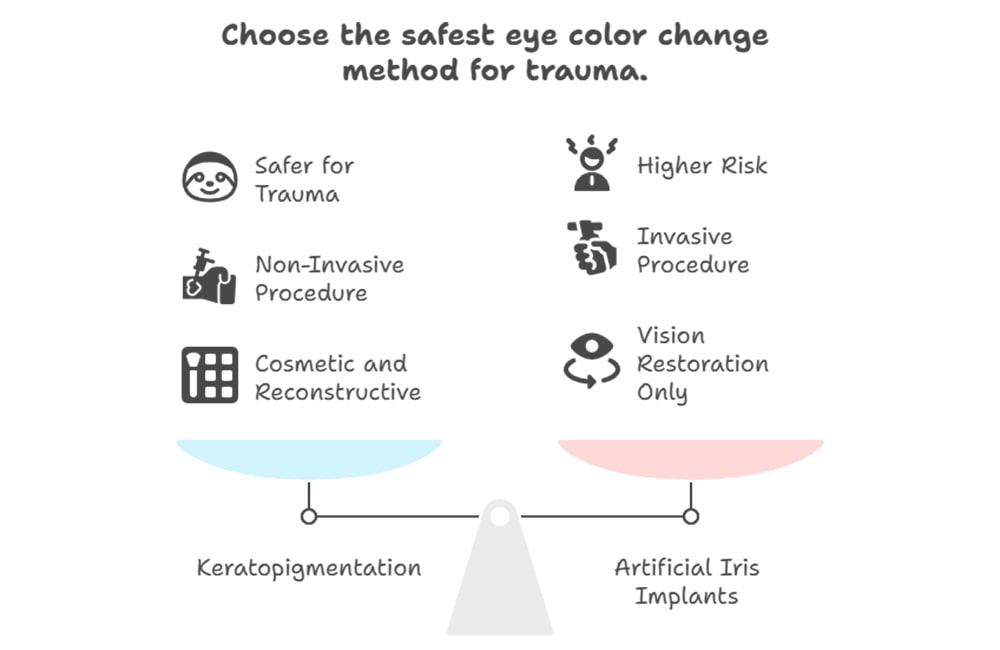

Can People with Corneal Scars Safely Change Their Eye Color?
Yes, and in fact, they are ideal candidates for keratopigmentation. This procedure is applied directly on the corneal layers, and in cases of existing scars, it can even be used to mask irregularities and restore symmetry. Many patients have reported improved quality of life and self-image after treatment.
Common Questions About Changing Eye Color in Injured Eyes
Short yes/no questions for the most concise and engaging answers:
1. Can eye color in injured eyes be changed through surgery? Yes
2. Are colored contact lenses safe for injured eyes? No
3. Is eye color change after injury permanent? Yes
4. Can injured eyes naturally regain their original color? No
5. Does eye color change in injured eyes affect vision? No
Psychological Impact of Eye Aesthetics After Trauma
Living with a visibly damaged or discolored eye can deeply affect one’s self-esteem, mental health, and social interactions. Eye color correction serves a dual purpose: it’s aesthetic and therapeutic. Patients often report:
• Increased self-confidence
• Reduced social anxiety
• A sense of reclaiming their identity
In post-trauma recovery, feeling normal again is invaluable, and that’s what this procedure helps to restore.
How Previous Eye Injuries Affect Surgical Outcomes
Surgeons at Ceritamed begin with a detailed eye exam including topography, optical coherence tomography (OCT), and pigment density scans. Factors that influence outcome include:
• Depth and location of scarring
• Type of previous trauma or surgery
• Current visual acuity
Proper assessment allows the team to personalize the method e.g. keratopigmentation for color addition.
Keratopigmentation vs Iris Implant: Which Is Safer for Damaged Eyes?
When comparing keratopigmentation and iris implants, the difference in safety is significant, especially in damaged or scarred eyes.
Keratopigmentation
- Performed on the cornea, not inside the eye.Less invasive and does not interfere with the internal ocular structure.
- Ideal for patients with corneal scars, heterochromia, or aniridia.
- Suitable for patients with a history of trauma or surgery.
Iris Implants
- Involve inserting artificial iris into the anterior chamber.
- High risk of complications like glaucoma, inflammation, and vision loss.
- Generally not recommended for patients with existing eye damage.
- However, for patients with complete loss of iris (aniridia), it’s sometimes the only way to restore functional and also ot is outdated.
For safety, longevity, and natural appearance, keratopigmentation remains the preferred choice offered by top clinics like Ceritamed in Iran and Oman. Yet, in specific cases (complete loss of iris or serious damages), iris implants are a necessary functional step.
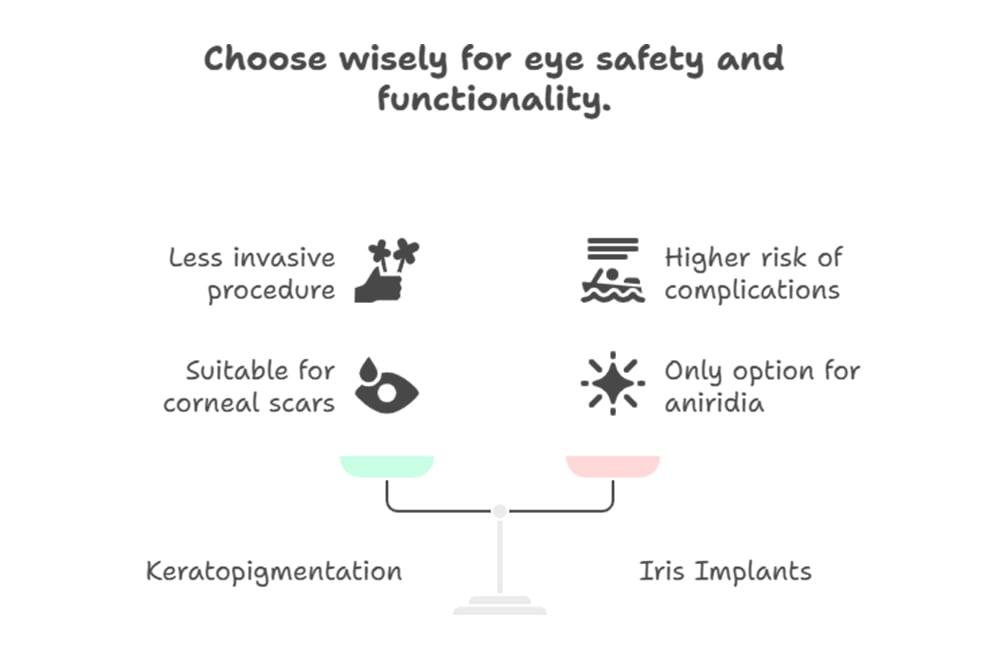
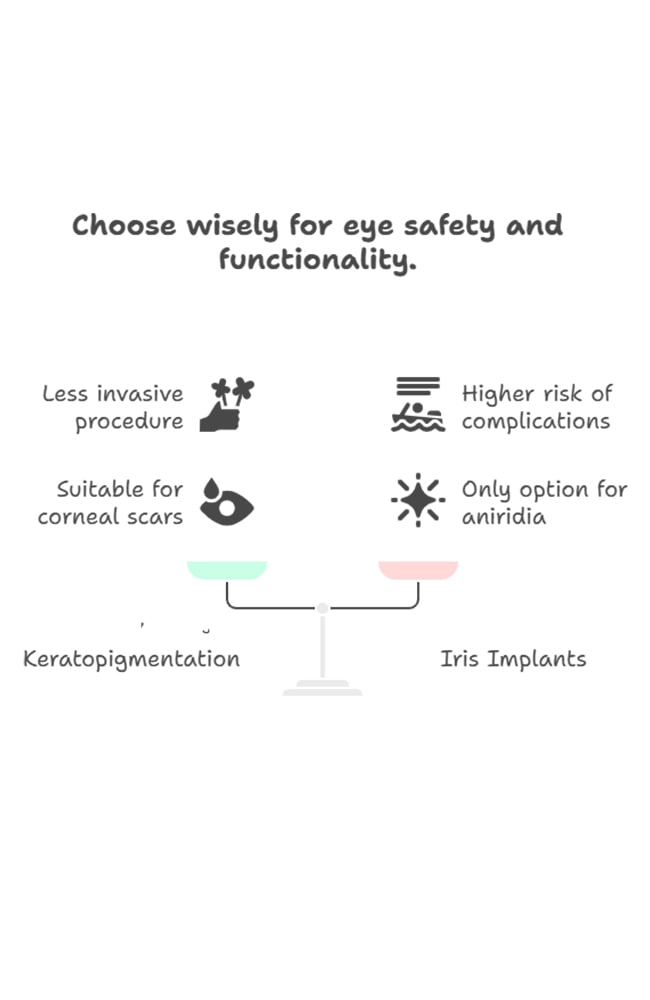
Understanding Keratopigmentation for Damaged Eyes
Keratopigmentation is tailored to each patient’s unique eye anatomy and medical history. Pigments are chosen to blend naturally with the healthy eye (if only one is damaged) or to create a new harmonious look if both eyes are affected. At Ceritamed, surgeons use advanced laser-guided techniques to ensure accuracy and avoid sensitive zones of the cornea.

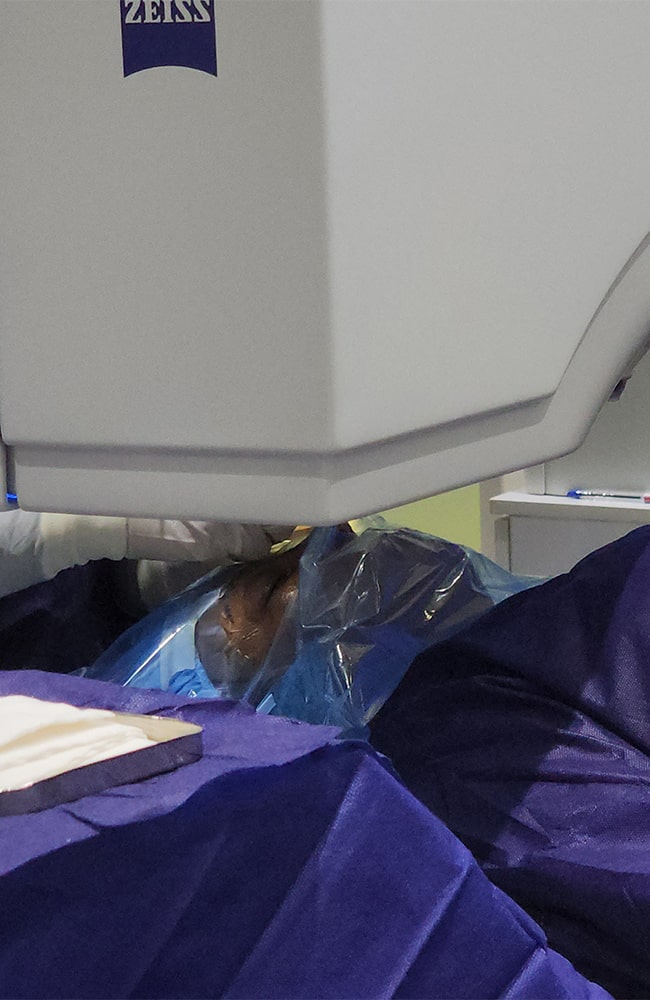
Are Iris Implants Safe for Eyes with Previous Trauma?
In short: No, unless the eye is completely missing the iris or incur serious iris damages. So, it`s the doctor who recognizes the best method suitable for your eyes. Artificial iris implants have been linked to serious complications in patients with past trauma. These include:
- Increased intraocular pressure
- Chronic pain and inflammation
- Loss of vision
Due to these risks, iris implants are strongly discouraged for patients with partial iris damage. But in cases of complete iris loss (aniridia) or serious damages to it, iris implants may be essential to restore any level of vision.
Step-by-Step Process of Eye Color Correction in Damaged Eyes
- Initial Consultation & Eye Mapping: Full diagnostics to assess eye health and damage.
- Customized Color Design: Pigment path designed based on your desired color and medical limitations.
- Procedure Day: Performed under topical anesthesia, often completed within 30–45 minutes In keratopigmentation but other solutions take more time or sessions like laser depigmentation.
- Recovery & Monitoring: Return to daily activities is usually possible within 24 hours. Mild initial side effects resolve within one week. Monthly check-ups are recommended for up to 6 months to ensure proper healing and monitor progress.
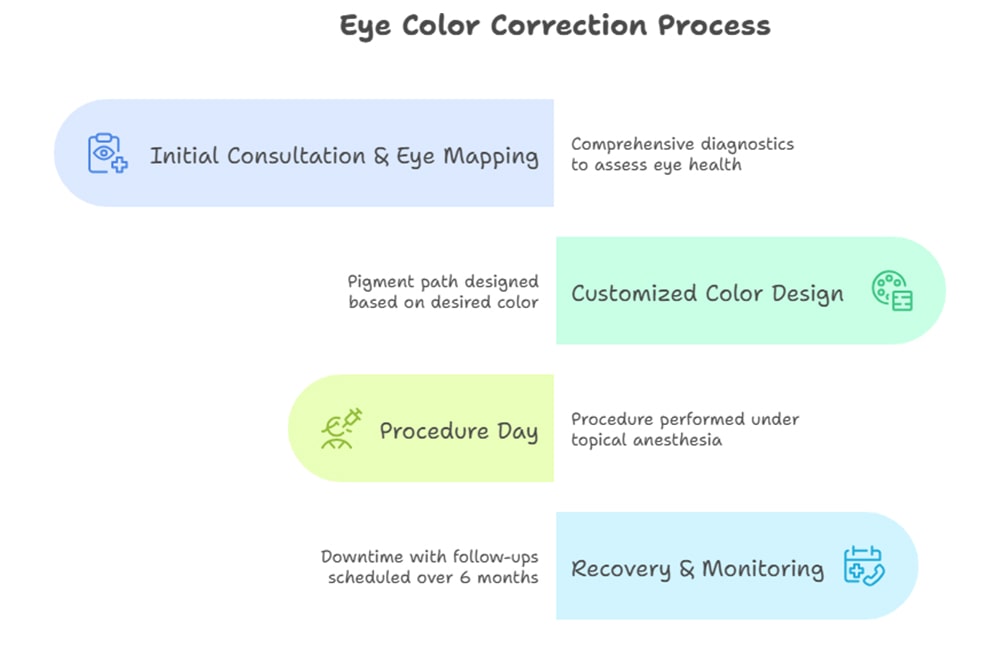
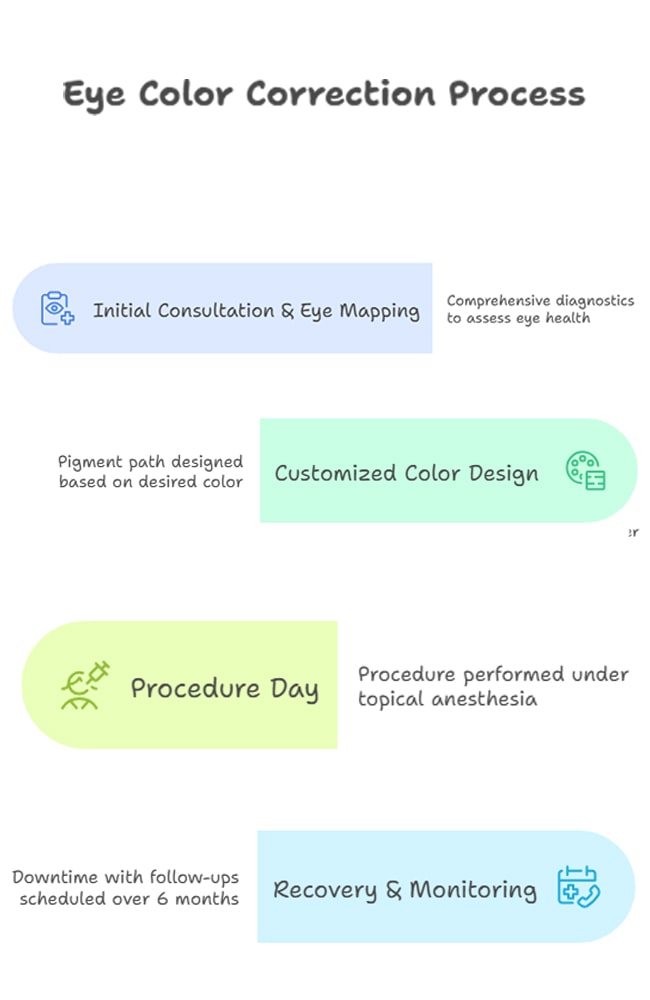
Comparison Table: Eye Color Change Methods by Risk and Cost
Method |
Ideal for Damaged Eyes |
Invasiveness |
Estimated Cost (per eye) (Iran/Oman) |
Risk Level |
|---|---|---|---|---|
|
Keratopigmentation |
Yes |
Very Low |
$ 6000 - 8000 |
Without any risks |
|
Laser Depigmentation |
Not Recommended but maybe needed in essential occasions by doctor`s recognition |
Low |
$ 850 - 1000 |
Low |
|
Iris Implants |
Only for complete iris loss or serious damages to iris and by doctor`s recognition |
High |
$ 10000 - 12000 |
High to Severe |
Real Cases: Eye Color Change Success Stories in Patients with Eye Damage
Farzaneh, an Afghan woman, lost the color of one eye in childhood after a glass injury. Lacking access to treatment, her eye turned completely white, leading to years of emotional distress and social judgment — even her own children were frightened by her appearance. After losing hope, she eventually underwent keratopigmentation, a cosmetic procedure that restored the eye’s natural look and She did the surgery at Ceritamed. Her family’s emotional reaction to her improved appearance marked a new, hopeful chapter in her life.
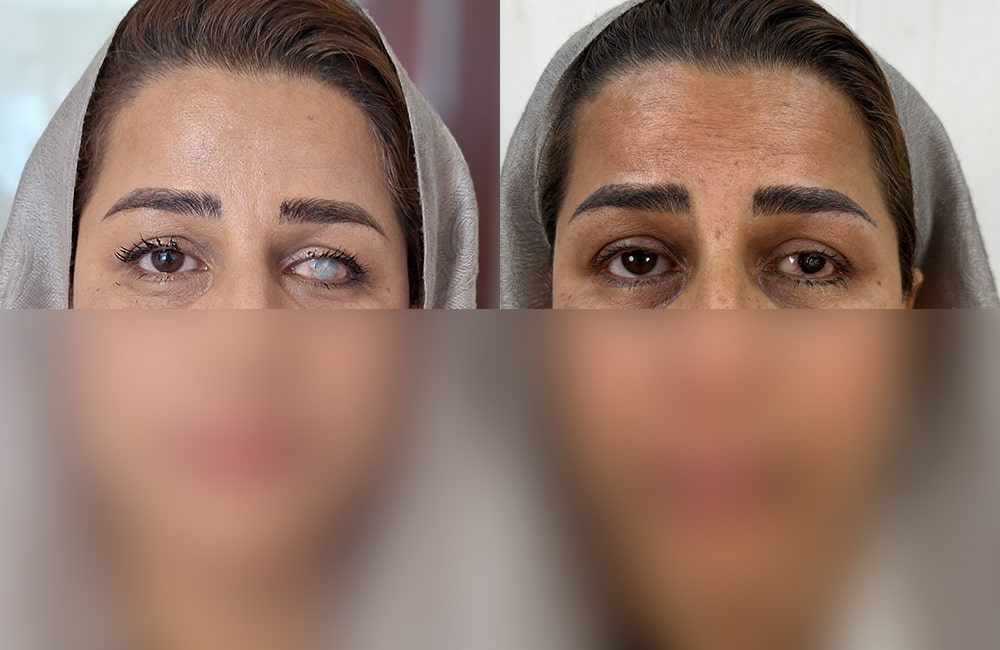
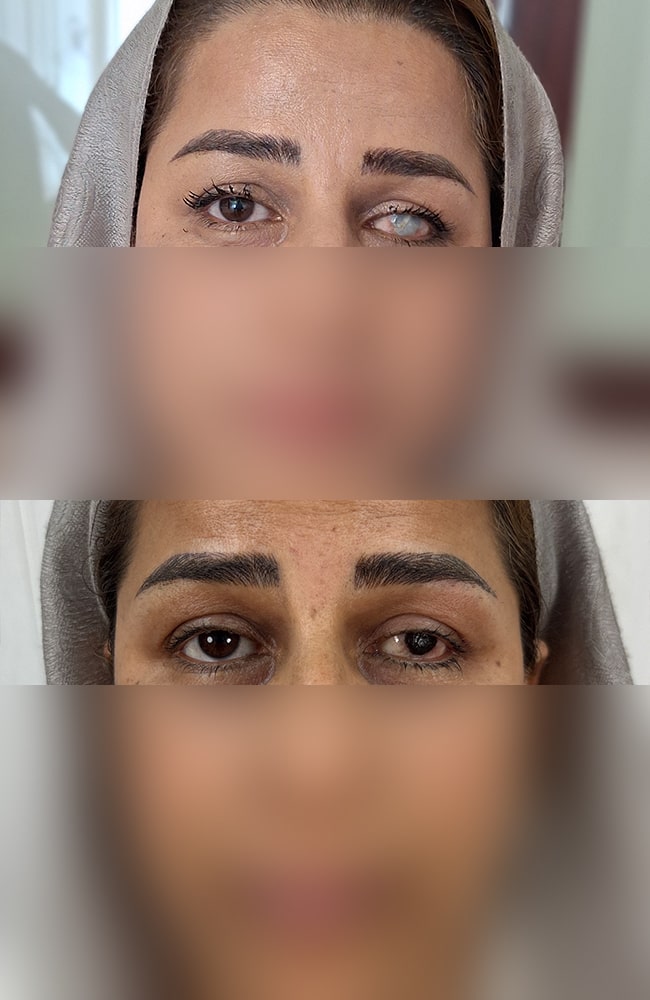
Is Eye Color Change Surgery Right for You After Injury or Scarring?
Choosing surgery after eye trauma is a deeply personal decision, but for many, the benefits are both emotional and physical. If you’ve suffered trauma, scarring, or pigment loss, you might wonder if eye color correction is right for you; exactly here you should ask an ophthalmologist to consider the best method of surgery based on your eyes condition.
Conclusion
For individuals with eye damage, changing eye color is not only possible—it’s safer and more effective than ever. Whether for symmetry, aesthetics, or psychological healing, procedures like keratopigmentation treatment offer hope and transformation. Ceritamed’s expert team in Iran and Oman combines medical precision with aesthetic vision, making them leaders in eye color correction for patients with injured or scarred eyes.
FAQs about Eye Color Change Options for Damaged or Injured Eyes
Can Chemical Eye Injuries Be Treated with Color Change?
Yes, if the injury is superficial or healed well, procedures like keratopigmentation can be safely performed. A full eye exam is needed to confirm eligibility.
What Are the Most Natural-Looking Results for Trauma Patients?
Custom pigments, advanced techniques like keratopigmentation, and careful color matching create highly natural results—especially for one-eye trauma cases.
Telephone consultation

Response on working days from 9 to 21
We've got everything you need to make an informed decision about changing your eye color.
Consultation Services
During the consultation process, you can ask all your questions and explore various eye color change methods with our team of specialists. We provide all the essential information you need to make an informed decision about changing your eye color.


